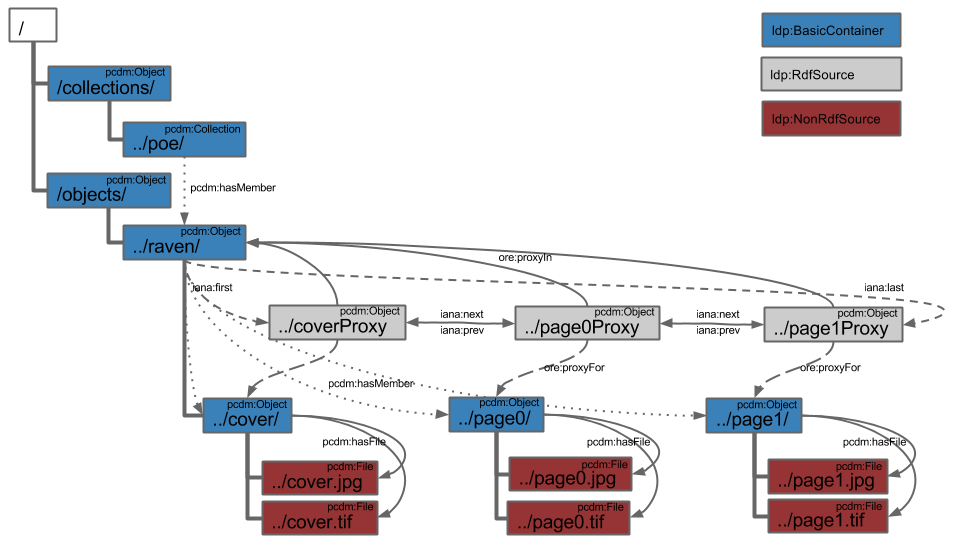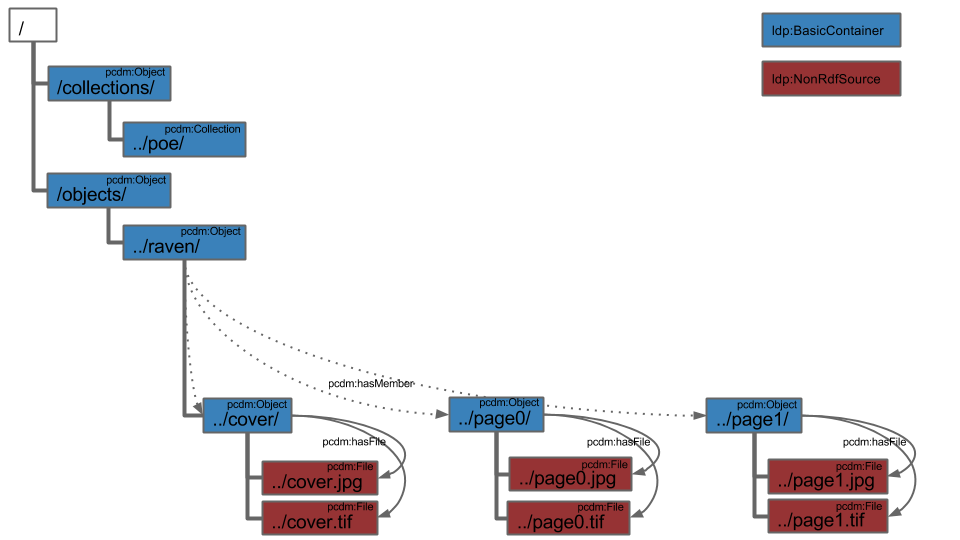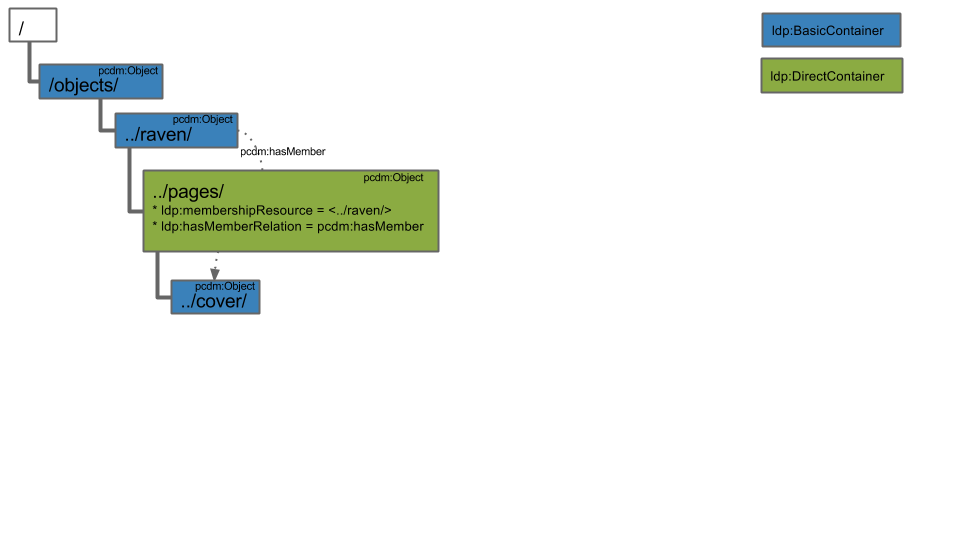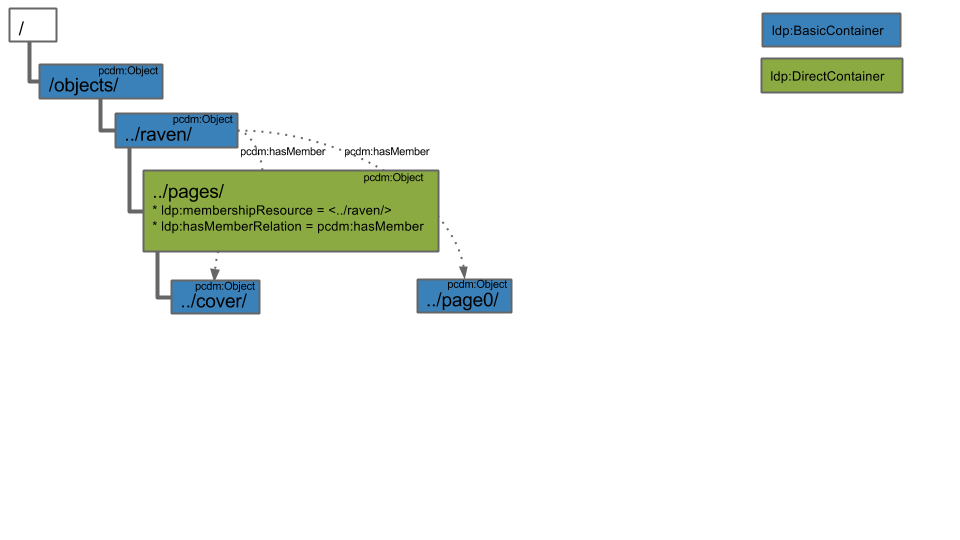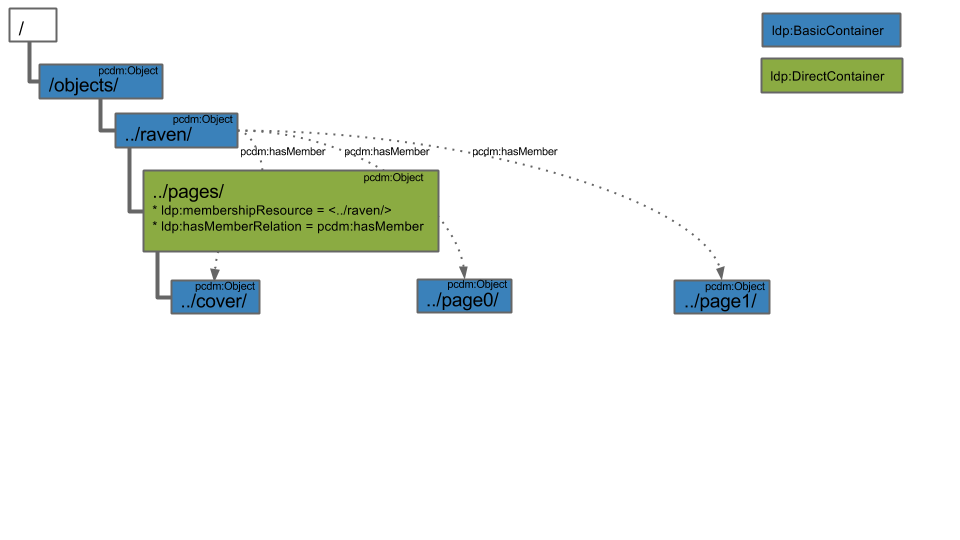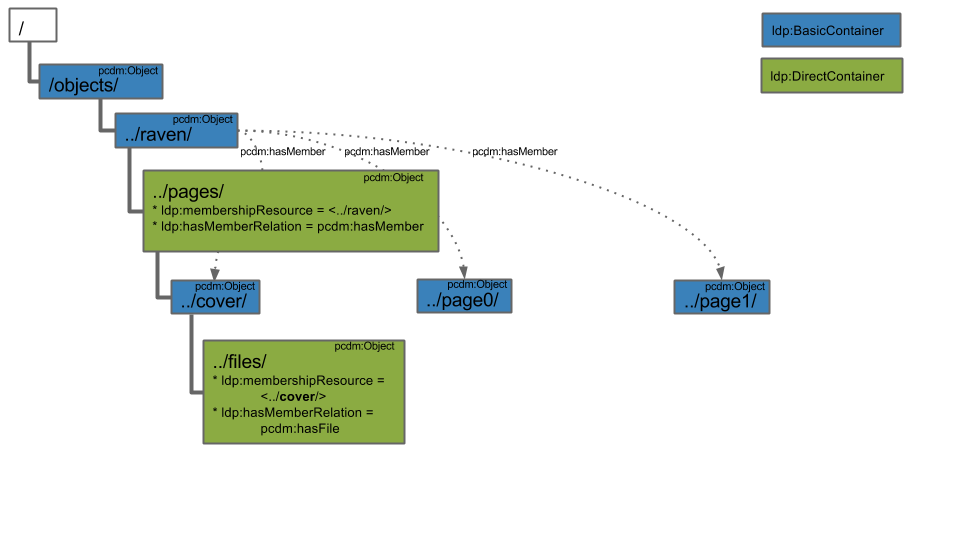Fedora4 (F4) implements the Linked Data Platform (LDP) W3C Recommendation. Additionally, the Portland Common Data Model (PCDM) has increasingly become adopted as a common content modeling approach in Fedora4.
This guide is designed to describe the details of both LDP and PCDM in the context of F4 by walking through a simple example of a single collection, consisting of a single book that implements page ordering.
This diagram depicts the logical structure of resources and relationships of a collection ("poe") that consists of a book ("raven") that consists of three pages that are ordered.
The following steps will walk through the process of creating this structure from the ground up.
The different types of LDP containers and sources will be detailed, as well as the PCDM types and relationships in the steps below.
- pcdm:Object
- pcdm:Collection
- pcdm:File
Additionally, there are two PCDM relationships that indicate resource membership and file membership:
- pcdm:hasMember
- pcdm:hasFile
The descriptions of these resource types and relationships may be found in the detailed Portland Common Data Model page.
Here we will begin to walk through the mechanics of creating the structures that will facilitate creation of the book and its pages.
First, create the top-level "objects/" pcdm:Object, which is also an ldp:BasicContainer.
curl -i -XPUT -H"Content-Type: text/turtle" --data-binary @pcdm-object.ttl localhost:8080/rest/objects/
Where "pcdm-object.ttl" follows:
@prefix pcdm: <http://pcdm.org/models#> <> a pcdm:Object .
Second, create the nested "raven/" pcdm:Object, which is also another ldp:BasicContainer.
curl -i -XPUT -H"Content-Type: text/turtle" --data-binary @pcdm-object.ttl localhost:8080/rest/objects/raven/
Lastly, create an ldp:DirectContainer, "pages/" that will facilitate the establishment of relationships between "raven/" and its constituent pages.
curl -i -XPUT -H"Content-Type: text/turtle" --data-binary @ldp-direct.ttl localhost:8080/rest/objects/raven/pages/
Where "ldp-direct.ttl" follows:
@prefix ldp: <http://www.w3.org/ns/ldp#> @prefix pcdm: <http://pcdm.org/models#> <> a ldp:DirectContainer, pcdm:Object ; ldp:membershipResource </rest/objects/raven/> ; ldp:hasMemberRelation pcdm:hasMember .
An ldp:DirectContaner is an LDP construct that activates the creation of certain RDF triples when a new resource is added as a child of this container.
Specifically, when an new resources is added inside of the "pages/" DirectContainer, a new triple on the ldp:membershipResource ("raven/") will be created with the predicate defined by the ldp:hasMemberRelation property ("pcdm:hasMember") and a subject that is a reference to the new resource.
We will see this in action next!
Create a new pcdm:Object, "cover/", that is also an ldp:BasicContainer within the "pages/" DirectContainer.
curl -i -XPUT -H"Content-Type: text/turtle" --data-binary @pcdm-object.ttl localhost:8080/rest/objects/raven/pages/cover/
Where "pcdm-object.ttl" follows:
@prefix pcdm: <http://pcdm.org/models#> <> a pcdm:Object .
As described in the previous step, the addition of "cover/" automatically creates the following new triple on "raven/"
<http://localhost:8080/rest/objects/raven/> pcdm:hasMember <http://localhost:8080/rest/objects/raven/pages/cover/>
Restating from the previous step,
- the subject of the triple comes from the "ldp:membershipResource" defined on "pages/"
- the predicate of the triple comes from the "ldp:hasMemberRelation" defined on "pages/", and
- the object of the triple is the new resource ("cover/") that was added to the ldp:DirectContainer ("pages/")
In the same fashion as the previous step, adding "page0/" to the DirectContainer, "pages/" results in a new auto-generated triple on "raven/" of the form:
<http://localhost:8080/rest/objects/raven/> pcdm:hasMember <http://localhost:8080/rest/objects/raven/pages/page0/>
curl -i -XPUT -H"Content-Type: text/turtle" --data-binary @pcdm-object.ttl localhost:8080/rest/objects/raven/pages/page0/
This step in creating the final page, "page1/", follows the same pattern shown in the previous two steps.
curl -i -XPUT -H"Content-Type: text/turtle" --data-binary @pcdm-object.ttl localhost:8080/rest/objects/raven/pages/page1/
In the same way that we used an ldp:DirectContainer to facilitate the auto-generation of triples linking "raven/" to each of the pages, now use the same pattern to auto-generate the creation of triples that link each page pcdm:Object to their various file representations.
To begin with, create an ldp:DirectContainer, "files/", which is also a pcdm:Object, as a child of "cover/" as follows:
curl -i -XPUT -H"Content-Type: text/turtle" --data-binary @ldp-cover-direct.ttl localhost:8080/rest/objects/raven/pages/cover/files/
Where "ldp-cover-direct.ttl" follows:
@prefix ldp: <http://www.w3.org/ns/ldp#> @prefix pcdm: <http://pcdm.org/models#> <> a ldp:DirectContainer, pcdm:Object ; ldp:membershipResource </rest/objects/raven/pages/cover/> ; ldp:hasMemberRelation pcdm:hasFile .
Now, any new resource that is added as a child of the DirectContainer "files/" will cause the auto-generation of a new triple on "cover/" that has a predicate of pcdm:hasFile and an object of the new resource.
Once again, we demonstrate the use of LDP in creating PCDM relationships simply as a result of repository interactions.
Add two pcdm:File resources to the DirectContainer, "files/" as follows:
curl -i -XPUT -H"Content-Type: image/jpeg" --data-binary @cover.jpg localhost:8080/rest/objects/raven/pages/cover/files/cover.jpg
Where "cover.jpg" is attached.
If you perform a subsequent HTTP HEAD on this new resource, you will see there is a "Link" header of rel="describedby". Update the RDF metadata of the ldp:NonRdfSource to specify that the resource is a pcdm:File, as follows:
curl -i -XPATCH -H"Content-Type: application/sparql-update" --data-binary @pcdm-file.ru localhost:8080/rest/objects/raven/pages/cover/files/cover.jpg/fcr:metadata
Where "pcdm-file.ru" follows:
PREFIX pcdm: <http://pcdm.org/models#>
INSERT {
<> a pcdm:File
} WHERE {
}
Repeat for the attached TIFF, cover.tif
curl -i -XPUT -H"Content-Type: image/tiff" --data-binary @cover.tif localhost:8080/rest/objects/raven/pages/cover/files/cover.tif curl -i -XPATCH -H"Content-Type: application/sparql-update" --data-binary @pcdm-file.ru localhost:8080/rest/objects/raven/pages/cover/files/cover.tif/fcr:metadata
After creating the two "cover" resources, an HTTP GET on "cover/" will include the two new triples:
<http://localhost:8080/rest/objects/raven/pages/cover/> pcdm:hasFile <http://localhost:8080/rest/objects/raven/pages/cover/files/cover.jpg> <http://localhost:8080/rest/objects/raven/pages/cover/> pcdm:hasFile <http://localhost:8080/rest/objects/raven/pages/cover/files/cover.tif>
Once again,
- the subject of the triple comes from the "ldp:membershipResource" defined on "files/"
- the predicate of the triple comes from the "ldp:hasMemberRelation" defined on "files/", and
- the object of the triple is the new resource ("cover.jpg" or "cover.tif") that was added to the ldp:DirectContainer ("files/")
